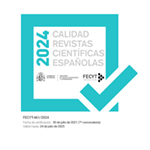Consideraciones sobre el coro y la liturgia musical en el Monasterio de Piedra entre los siglos XII y XVI
Resumen
El Monasterio de Santa María de Piedra fue fundado en 1195. Como la mayoría de las abadías cistercienses masculinas de la Corona de Aragón, perdió casi todo su patrimonio artístico en el s. XIX. Aunque la información actualmente disponible es incompleta, se tienen datos suficientes como para afirmar que tuvo dos coros, uno de monjes y otro de hermanos legos conversos, ambos con sillería de madera. Respecto a la organología, en el altar relicario donde se veneraba la Santa Duda de Cimballa, pintado en 1390, están representados ocho ángeles músicos cuyos instrumentos permiten hacerse una idea del enriquecimiento de la liturgia que se interpretaba en Piedra. En 1496 consta que Pascual de Mallén construyó un órgano de grandes dimensiones. Del repertorio musical sólo conocemos la prosa de un Hosanna gracias al epígrafe que figura en el nimbo de uno de los ángeles músicos, los datos recogidos en la Consueta del s. XV de la Biblioteca Nacional, y un antifonario usado en noviembre, compuesto por Fernando Liñán en 1597, que se conserva en el Monasterio de San Pedro de Cardeña. Se propone el estudio del coro y la liturgia musical del Monasterio de Piedra entre los s. XII y XVI.











